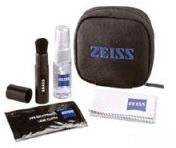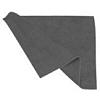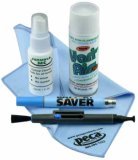
|
Photographic Lens and Filter CleaningThe best way to keep lenses and filters clean is not to get them get dirty in the first place! This may sound trite, but every cleaning carries with it a very small risk of causing problems. The major problem is the risk of scratching. Scratching occurs when something harder than glass (or the optical coating) is rubbed on the lens. Of course lens cleaning tissues, cloths, brushes and fluids aren't harder than glass, but dust and dirt may be. Hardness can be measured on the Knoop scale. For our purposes here it doesn't really matter what the numbers mean, but it is important to know that a material with a higher number will scratch a material with a lower number. Here are some typical values:
As you can see, coatings and optical glass have a hardness in the 450-600 range. This is pretty hard, harder than most metals for example. Try scratching a microscope slide with a pen knife. You won't be able to do it (but don't try this with your lens, just in case...). Fluorite (a lens material used by Canon in their "L" series telephoto lenses) isn't very hard at all, and that's at least one reason why fluorite lens elements are used between regular glass elements. If a fluorite element was used as the front element in a lens it would easily scratch, so if the design calls for that, a permanent multicoated flat glass "filter" element is used in front of it - and that's why some of the long Canon telephotos use such a fixed "filter". While many metals are softer than optical glass and won't scratch it, many minerals are harder and will. Sand (quartz) will easily scratch optical glasses and coatings, Many silicate minerals such as Feldspars - which make up most of the earth's crust (e.g. Granite) - are also hard enough to scratch optical glass. A lot of "dust" and "dirt" contain bits of ground up rock, and that's what can scratch your lens or filter. The particles can be too small to see and still do damage. Cleaning OpticsThe first step in cleaning an optical surface is to gently remove the dust. You can do this with a blower (either a bulb blower or some form of compressed gas) or a soft brush. Hopefully this will remove all the particles of hard minerals from the surface without causing any scratches. While blowing or brushing can remove surface dust, it won't remove things like oil or material stuck to the lens, such as the residue of sea spray left on the lens after the water evaporates (i.e. salt). To remove these material a solvent is probably required, either water based (to remove water soluble compounds) or something which dissolves oil, such as an alcohol. Solvents should always be applied on some sort of tissue, never poured onto a lens. You don't want excess liquid getting inside the lens where it can, for example, dissolve lubricating oils and redeposit them on internal elements. You can buy a number of commercial lens cleaning fluids or, if you can find them, you can use pure alcohols such as methanol, ethanol or iso-propanol. Methanol is the preferred solvent, but it can be toxic if misused and it may be difficult to find pure. Ethanol (ordinary "alcohol") and Iso-propanol are much less toxic and easier to find. If you use an alcohol make sure it's pure and doesn't have some sort of non-volatile additive. You can also try distilled water (water without any minerals dissolved in it). One way to put a film of "distilled" water on a surface is to breath on it. The water vapor in your breath will condense on a cooler surface as pure water. You can then wipe the condensation off the surface with a lens tissue or cloth. One solvent to avoid or to use with great care is Acetone. It's very, very good at removing grease. However it's also very, very good at dissolving plastics and paint. It's also difficult to find commercially in a pure form. Unless you have a surface so badly contaminated that Methanol won't clean it, I'd avoid Acetone. However if you get something like tar on the glass (how you'd do that, I don't know), then Acetone might be the only thing that will remove it. You might also want to avoid household glass cleaners (like Windex), which may contain things like ammonia and dyes. If you want to be safe, stick with the commercially available lens cleaning fluids (see below). A word about lens tissues and lens cloths. Make sure they are clean. Lens tissues should be used once then thrown away. The very last thing you want to be wiping across your lens is a tissue with a piece of grit embedded in it! Lens cloths should be washed frequently and kept in a clean plastic bag when not in use. Microfiber cloths are excellent and the only type of cloth I would use myself. They are made of a very, very small fibers made of a polyester/polyamide material. The fibers are often as small as 1 micron in diameter - which is 1/100th of the diameter of a human hair. Pretty small! The fibers are also often wedge shaped or triangular rather than smooth and round. They act to "suck up" dirt and oil when wiped over a surface and absorb them via a mechanism which resembles capillary action between the tiny fibers. Multicoated lens and filter surfacesIt's sometimes said that it's more difficult to clean multicoated lenses and filters than uncoated versions, but that isn't true. What is true is that oil is much more visible on multicoated optics, so it's more difficult to remove every visible trace. For example, a grease smear (possibly left over from a fingerprint) which shows up on a multicoated filter would be invisible on an uncoated filter. There would be the same amount of contamination on both. The oil is more visible on the multicoated filter because it negates the anti-reflection effect of the coating and so appears as a brighter spot. On an uncoated filter the surface reflectivity is essentially unaffected, so it's harder to see. It's also said that you need to take more care cleaning coated and multicoated optics than uncoated optics. This isn't generally true for modern lenses. If a coating is properly applied, it can be as hard as the original glass and it bonds very strongly to the glass surface. Properly applied coatings can't be removed with lens cleaning solvents, nor can they be "rubbed off". Of course anything is possible if the coating hasn't been applied properly. However for most modern "name brand" multicoated lenses and filters, normal care is all that's needed for cleaning. However if you're cleaning older lenses then some extra care may be needed. Though I have no personal experience it's said that some coated lenses though the 1950s and maybe even as late as the 1960s had fairly soft coatings. The early Leitz 50/2 Summicron is sometimes cited as an example of a lens with a coating that can be easily scratched. It's also said that some early coatings don't adhere to the glass as well as modern coatings and can also be attacked by cleaning fluids containing ammonia (like Windex), so that's another factor to bear in mind when working with coated optics made before the 1960s. When to Clean a Lens or Filter?Just when should you clean a lens or filter? Well, the short answer is as infrequently as possible. It actually takes quite a lot of dirt on an optical surface before the image quality noticeably degrades. A surface with a lot of "cleaning marks" will do more damage than one with a few specs of dust. "Cleaning marks" tend to scatter light and so lower contrast in some situations. So blow or brush loose dust off a lens when you see it there, but don't clean it "just to make sure". If it doesn't look dirty, leave it alone. Suggested Products for Lens and Filter CleaningThere are lots of lens and filter cleaning accessories out there, too many to list them all. However here's a small selection that covers most needs and which certainly won't break the bank! If nothing else you should certainly keep a microfiber cloth or a lens pen in your camera bag.
© Copyright 2005 Bob Atkins All Rights Reserved |
|||||||||||||||||||||||||||||||||||



